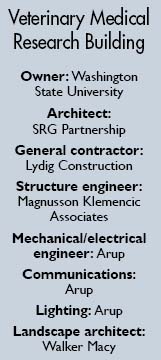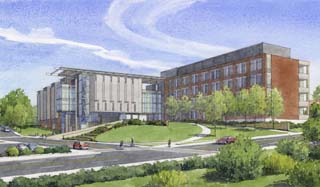|
Subscribe / Renew |
|
|
Contact Us |
|
| ► Subscribe to our Free Weekly Newsletter | |
| home | Welcome, sign in or click here to subscribe. | login |
Construction
| |
 |
November 18, 2010
Veterinary medical building: a melting pot for research
SRG Partnership

Evans
|
Washington State University recently celebrated the groundbreaking of the Veterinary Medical Research Building, or VMRB, the third building of seven that will shape the campus’ redeveloped Research and Education Complex. The complex will occupy 11 acres east of Stadium Way to create a total of 750,000 square feet dedicated to multidisciplinary research.
The new five-story structure, designed by SRG Partnership, anchors the north end of the complex’s circulation spine, which links the various buildings and incorporates their lobbies, conference rooms, shared facilities and interaction spaces. The VMRB’s position fronting Ferdinand Lane to the north will make it a prominent campus landmark at the major intersection of Campus Way and Ferdinand Lane.
The VMRB will house existing and new faculty from the College of Veterinary Medicine’s Department of Veterinary and Comparative Anatomy, Pharmacology and Physiology, as well as faculty from the departments of Animal Sciences and Experimental Psychology.
Researchers here will investigate animal and human health and well-being in order to discover the neuroscience underlying associated problems, such as addiction, obesity and mental illness. The interdisciplinary character of the new building will create a melting pot for faculty and scholars from various backgrounds to pursue breakthrough discoveries.
Lab ‘neighborhoods’
SRG’s design for the VMRB features a dramatic cantilevered roof over the circulation spine, supported by 80-foot freestanding concrete columns at the north end to produce the “Science Forum,” a unique multiuse social space located adjacent to the spine on the third and fourth floors.
This space will accommodate a wide range of activities, from formal presentations and seminars to informal lunch gatherings and “poster sessions” for research teams to share their work with colleagues. The interior space includes acoustical wood panels, concrete and wood amphitheater-style seating, and sophisticated audio-visual presentation systems. The exterior further accentuates the Science Forum by incorporating dichroic glass fins to refract colored light across the metal panel cladding.
The concrete structure is exposed to view throughout the spine and in other areas of the building, illuminated by daylight through glass curtain walls or electric lighting when necessary. The 16-foot floor-to-floor heights necessary for laboratory utility distribution make for large volumes, in some cases emphasized by double-height spaces that underscore the importance of the circulation spine while creating vertical connections. A trapezoidal stair enclosure, also cantilevered from the spine, contributes to the building’s dynamic effect and connects to its north entrance ground-floor lobby and the overall complex.

Transparency and connectivity are emphasized in the laboratory and office areas. Alternating zones of open labs and offices and enclosed support labs and private offices extend through the building. These open areas allow natural light to penetrate and visually link lab and office spaces via glass partitions between the spaces.
The labs are arranged in “neighborhoods” that are linked to adjoining neighborhoods via equipment corridors. This organization of alternating “open” and “closed” zones is expressed on the exterior for a sense of continuity; brick veneer and window openings correspond to “closed” zones, and glazed curtain walls correspond to “open” zones.
The design of the lab spaces emphasizes flexibility and adaptability via a modular laboratory plan that incorporates mobile casework systems that allow researchers to easily modify layouts and equipment to respond to changing needs. Utilities are delivered to these lab areas using a custom-designed overhead services carrier. Research teams are thus able to modify their laboratory areas without hiring plumbers or electricians, saving both cost and time.
Energy-efficient systems
Laboratory buildings are much more energy intensive than typical offices and classrooms, so conservation measures in their case are distinctly important. Designed to LEED silver standards, the VMRB includes numerous sustainability features.
Shading elements allow daylight to enter the building without solar heat gain, reduce the amount of electricity needed for lighting and minimize cooling loads. Heat is recovered from the ventilation systems and used to pre-heat the air delivered to spaces.
The efficient mechanical system includes chilled beams to address the heat rejection of the extensive scientific instrumentation, and while common in Europe for many years as an extremely effective cooling strategy, the VMRB will be one of the largest installations of chilled beams in the Northwest.
The building is expected to perform 48 percent better than the state energy code, and an extensive system of monitoring devices is being incorporated to validate performance and optimize operation of systems. Low-flow fixtures and fittings and various strategies are being used to reclaim and minimize the consumption of water.
The project, which has an estimated construction cost of $59 million, is using an accelerated schedule and procurement process to deliver the project sooner and capitalize on a very competitive construction market. Construction work on excavation, shoring, foundations and site utilities has begun.
The second bid package, covering the building superstructure, takes place this month. The balance of work will be procured under a third bid package scheduled for February of 2011. The university’s total project budget is $96 million. Building occupancy is scheduled for November of 2012.
Tim Evans is a principal at SRG Partnership.
Other Stories:
- Have a campus project? Look out for trees
- Budgets dwindle, but master planning goes on
- Renovation ensures a campus hub for years to come
- In new WSU dorm, each floor is a neighborhood
- Top 10 WSU projects
- Top 10 UW projects
- Historic warehouse gets an academic makeover
- UW's Foster business school built on connections
- UW ramping up $833M housing plan



